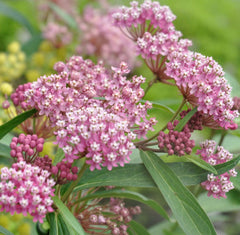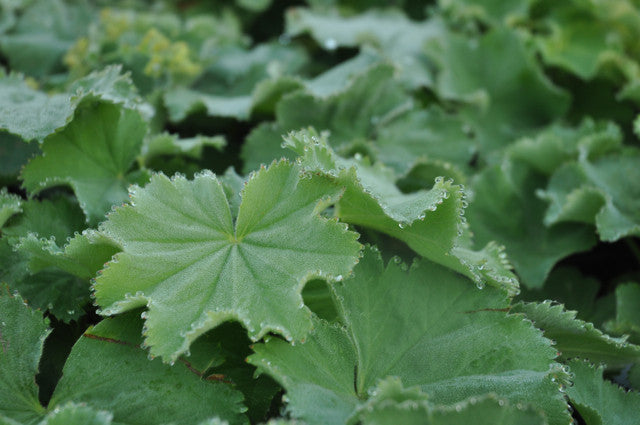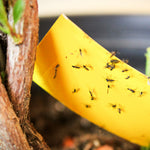 A little rain and we are happy not to have to water; big down pours again and again, and plants can really start to suffer. The main trouble with soggy soil is that plants' roots become starved for oxygen, which gets displaced in the dirt by all that moisture. Plants require oxygen in the soil to facilitate healthy root functioning, and also to promote the health of the aerobic micro-organisms that support root and plant functions. As soil moisture lingers, so increases the potential for trouble. Poorly oxygenated, wet soil leads to root rot and generally weak plants; fungal diseases are particularly common during drenched conditions (both in the roots and on the leaves & stems). Unfortunately this is something many gardeners are now reporting.
A little rain and we are happy not to have to water; big down pours again and again, and plants can really start to suffer. The main trouble with soggy soil is that plants' roots become starved for oxygen, which gets displaced in the dirt by all that moisture. Plants require oxygen in the soil to facilitate healthy root functioning, and also to promote the health of the aerobic micro-organisms that support root and plant functions. As soil moisture lingers, so increases the potential for trouble. Poorly oxygenated, wet soil leads to root rot and generally weak plants; fungal diseases are particularly common during drenched conditions (both in the roots and on the leaves & stems). Unfortunately this is something many gardeners are now reporting. What to do about all of the wet weather...

 A little rain and we are happy not to have to water; big down pours again and again, and plants can really start to suffer. The main trouble with soggy soil is that plants' roots become starved for oxygen, which gets displaced in the dirt by all that moisture. Plants require oxygen in the soil to facilitate healthy root functioning, and also to promote the health of the aerobic micro-organisms that support root and plant functions. As soil moisture lingers, so increases the potential for trouble. Poorly oxygenated, wet soil leads to root rot and generally weak plants; fungal diseases are particularly common during drenched conditions (both in the roots and on the leaves & stems). Unfortunately this is something many gardeners are now reporting.
A little rain and we are happy not to have to water; big down pours again and again, and plants can really start to suffer. The main trouble with soggy soil is that plants' roots become starved for oxygen, which gets displaced in the dirt by all that moisture. Plants require oxygen in the soil to facilitate healthy root functioning, and also to promote the health of the aerobic micro-organisms that support root and plant functions. As soil moisture lingers, so increases the potential for trouble. Poorly oxygenated, wet soil leads to root rot and generally weak plants; fungal diseases are particularly common during drenched conditions (both in the roots and on the leaves & stems). Unfortunately this is something many gardeners are now reporting. Here are some ideas on how to manage wet conditions:
BEFORE PLANTING
- Ensure in-ground beds are raised, and not situated in low areas of the garden.
- Avoid creating new beds that are excavated. Instead, build up from grade, using cardboard over top of lawn (or what ever is there to start). Benefits include avoiding a ton of back-breaking digging, and the new garden will not settle into a low spot (as it tends to when you start by digging old stuff out).
- Create raised garden boxes (minimum 11" tall) that are much better at draining compared to traditional in-ground beds.
- Plant trees and shrubs slightly raised so that as they settle they do not end-up sitting low in the ground.
- Plan for drainage-loving herbs and veggies to be in well drained pots, so they can be moved out of persistent rain if necessary, and also allow excess moisture to move through the container and away from the roots.
- Use mycorrhizal at time of planting. Products such as MYKE dramatically improve root functioning by establishing a life-long symbiotic relationship between plants' roots and the beneficial fungus (mycorrhizae); this aids in supporting root health, including during adverse conditions (primarily by warding-off disease pathogens, such as root fungus). While many gardeners are now familiar with using MYKE on trees and shrubs, it is less well known that mycorrhizae are beneficial to annuals and perennials as well.
FOR EXISTING GARDENS
- Thin plants to increase air flow through foliage and into soil. Opening things up is a strategy that applies to most types of plants, from tomatoes to perennial flowers to trees and shrubs. The degree of pruning may be different, but the goal is the same: cut back or thin out in such a way as to allow maximum light and air penetration.
- Thin plants to increase light penetration, which helps ensure leaves and stems dry out daily. As an example, tomatoes require 24" of space between plants, a rule that is all the more important when conditions are very wet.
- Tidy-up leaf debris which can harbour fungal spores.
- For tomatoes and other veggies, mulch around plants to minimize splash-up from soil onto lower leaves. Use a loose mulch such as dried leaves, shredded paper or
- Prune out non-flowering leafy stems on tomatoes, or at least prune up the lower ones. Here is a link to a fantastic article on pruning tomatoes, published in Fine Gardening (not written by Sage Garden). Many times disease is transfered from soil to plant via the bottom leaves.
- Always water at the base of plants, and avoid getting water on the leaves (although gardeners are generally aware of this, there is something so tempting about splashing that water from above!). Fungal diseases become common when moisture sits on leaves.
- Water containers and raised beds as soil feels dry to the touch; if damp , check the next day.
- Use gardener and environmentally friendly fungicides to treat problems such as powdery mildew, leaf spotting, and soil borne fungal concerns, if treatment is required. Safer's 3-in-1 is a good example (sulfur and soap based).






